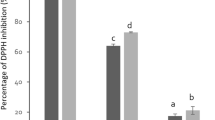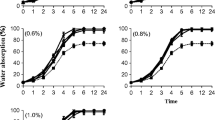Abstract
Biostimulants obtained from seaweeds contain excellent nutrient sources to enhance plant growth and high crop yield. In this study, the seaweed liquid extract (SLE) was prepared from three seaweeds, namely Ulva intestinalis extract (UIE), Portieria hornemannii extract (PHE), and Turbinaria ornata extract (TOE). The SLE was categorized into seven possible combinations (single SLE and mixture of SLE), and the combinations were diluted into six strengths (minimum of 10%, subsequently 20%, 30%, 40%, 50%, and a maximum of 100%). The SLE preparations were evaluated for their growth stimulation properties on Solanum lycopersicum seeds and plants in the pot study. The plants treated with UIE (30%) exhibited a notable response in seed germination (90%); improved growth parameters such as plant height (shoot length (51%), root length (71%)), biomass (fresh weight (60%), dry weight (65%)), leaf parameter (leaf count (55%), leaf area (212%)), biochemical content (carbohydrates (83%), proteins (78%), amino acids (68%), phenolics (106%)), and pigment content (carotenoid (58%), chlorophyll a (94%), chlorophyll b (74%)) when compared with control (water). Further, the UIE (30%) displayed an upsurge (95%) in the yield (2037.5 g/ plant) when compared with water-treated plants (1042.3 g/ plant). Based on the present study, the SLE (particularly UIE) illustrated better biostimulant activity on S. lycopersicum. The results suggest that SLE prepared from seaweed can be used as a better choice of fertilizer due to its biostimulant activity.









Similar content being viewed by others
Data availability
Not applicable.
References
Aires T, Muyzer G, Serrão EA, Engelen AH (2019) Seaweed loads cause stronger bacterial community shifts in coastal lagoon sediments than nutrient loads. Front Microbiol 10:1–18. https://doi.org/10.3389/fmicb.2018.03283
Alaoui I, El Ghadraoui O, Serbouti S et al (2022) The mechanisms of absorption and nutrients transport in plants: A review. Trop J Nat Prod Res 6:8–14. https://doi.org/10.26538/tjnpr/v6i1.2
Ali MY, Sina AAI, Khandker SS et al (2021a) Nutritional composition and bioactive compounds in tomatoes and their impact on human health and disease: A review. Foods 10:1–32. https://doi.org/10.3390/foods10010045
Ali O, Ramsubhag A, Jayaraman J (2021b) Biostimulant properties of seaweed extracts in plants: Implications towards sustainable crop production. Plants 10:1–27. https://doi.org/10.3390/plants10030531
Brown PH, Zhao FJ, Dobermann A (2022) What is a plant nutrient? Changing definitions to advance science and innovation in plant nutrition. Plant Soil 476:11–23. https://doi.org/10.1007/s11104-021-05171-w
Chanthini KMP, Stanley-Raja V, Thanigaivel A et al (2019) Sustainable agronomic strategies for enhancing the yield and nutritional quality ofwild tomato, solanum lycopersicum (1) Var Cerasiforme Mill. Agronomy 9:1–22. https://doi.org/10.3390/agronomy9060311
Dookie M, Ali O, Ramsubhag A, Jayaraman J (2021) Flowering gene regulation in tomato plants treated with brown seaweed extracts. Sci Hortic (amsterdam) 276:1–8. https://doi.org/10.1016/j.scienta.2020.109715
EL Boukhari MEM, Barakate M, Bouhia Y, Lyamlouli K (2020) Trends in Seaweed Extract Based Biostimulants : Manufacturing Process and. Plants 23
FAOSTAT. https://www.fao.org/faostat/en/#data/QCL/visualize. Accessed 5 Feb 2023
Fertilizer Nutrient Management. https://www.ctahr.hawaii.edu/mauisoil/c_material.aspx. Accessed 11 Feb 2023
Godlewska K, Michalak I, Tuhy L, Chojnacka K (2016) Plant Growth Biostimulants Based on Different Methods of Seaweed Extraction with Water. Biomed Res Int 1–11. https://doi.org/10.1155/2016/5973760
Gonçalves AL (2021) The use of microalgae and cyanobacteria in the improvement of agricultural practices: A review on their biofertilising, biostimulating and biopesticide roles. Appl Sci 11:1–21. https://doi.org/10.3390/app11020871
Hernández-Herrera RM, Santacruz-Ruvalcaba F, Ruiz-López MA et al (2014) Effect of liquid seaweed extracts on growth of tomato seedlings (Solanum lycopersicum L.). J Appl Phycol 26:619–628. https://doi.org/10.1007/s10811-013-0078-4
Hernández-Herrera RM, Santacruz-Ruvalcaba F, Zañudo-Hernández J, Hernández-Carmona G (2016) Activity of seaweed extracts and polysaccharide-enriched extracts from Ulva lactuca and Padina gymnospora as growth promoters of tomato and mung bean plants. J Appl Phycol 28:2549–2560. https://doi.org/10.1007/s10811-015-0781-4
Howard J (2019) Dead zones, facts and information. In: Natl. Geogrophic. https://www.nationalgeographic.com/environment/article/dead-zones. Accessed 8 Feb 2023
Hussain HI, Kasinadhuni N, Arioli T (2021) The effect of seaweed extract on tomato plant growth, productivity and soil. J Appl Phycol 33:1305–1314. https://doi.org/10.1007/s10811-021-02387-2
Karthik T, Sarkar G, Babu S et al (2020) Preparation and evaluation of liquid fertilizer from Turbinaria ornata and Ulva reticulata. Biocatal Agric Biotechnol 28:1–10. https://doi.org/10.1016/j.bcab.2020.101712
Krishnasree R, Raj SK, Chacko SR (2021) Foliar nutrition in vegetables: A review. J Pharmacogn Phytochem 10:2393–2398. https://doi.org/10.22271/phyto.2021.v10.i1ah.13716
Lobo LLB, de Andrade da Silva MSR, Castellane TCL, et al (2022) Effect of Indole-3-Acetic Acid on Tomato Plant Growth. Microorganisms 10:1–14. https://doi.org/10.3390/microorganisms10112212
Louime C, Fortune J, Gervais G (2017) Sargassum Invasion of Coastal Environments: A Growing Concern. Am J Environ Sci 13:58–64. https://doi.org/10.3844/ajessp.2017.58.64
Lowry OH, Rosebrough NJ, Farr AL, Randall R (1951) Protein determination with the Folin phenol reagent. J Biol Chem 193:265–275. https://doi.org/10.1016/0304-3894(92)87011-4
Makhaye G, Aremu AO, Gerrano AS et al (2021) Biopriming with seaweed extract and microbial-based commercial biostimulants influences seed germination of five abelmoschus esculentus genotypes. Plants 10:1–10. https://doi.org/10.3390/plants10071327
Malone TC, Newton A (2020) The Globalization of Cultural Eutrophication in the Coastal Ocean: Causes and Consequences. Front Mar Sci 7:1–30. https://doi.org/10.3389/fmars.2020.00670
Mathur C, Rai S, Sase N et al (2015) Enteromorpha intestinalis Derived Seaweed Liquid Fertilizers as Prospective Biostimulant for Glycine max. Braz Arch Biol Technol 58:813–820
Muniswami DM, Chinnadurai S, Sachin M, et al (2021) Comparative study of biofertilizer/biostimulant from seaweeds and seagrass in Abelmoschus esculentus crop. Biomass Convers Biorefinery 1–18. https://doi.org/10.1007/s13399-021-01881-4
Murtic S, Oljaca R, Murtic MS et al (2018) Effects of seaweed extract on the growth, yield and quality of cherry tomato under different growth conditions. Acta Agric Slov 111:315–325. https://doi.org/10.14720/aas.2018.111.2.07
Muthu-Pandian Chanthini K, Senthil-Nathan S, Stanley-Raja V et al (2019) Chaetomorpha antennina (Bory) Kützing derived seaweed liquid fertilizers as prospective bio-stimulant for Lycopersicon esculentum (Mill). Biocatal Agric Biotechnol 20:101190. https://doi.org/10.1016/j.bcab.2019.101190
Mzibra A, Aasfar A, Benhima R et al (2021) Biostimulants Derived from Moroccan Seaweeds: Seed Germination Metabolomics and Growth Promotion of Tomato Plant. J Plant Growth Regul 40:353–370. https://doi.org/10.1007/s00344-020-10104-5
Nakhate P, van der Meer Y (2021) A systematic review on seaweed functionality: A sustainable bio-based material. Sustain 13:. https://doi.org/10.3390/su13116174
Nekvapil F, Ganea IV, Ciorîță A et al (2021) A new biofertilizer formulation with enriched nutrients content from wasted algal biomass extracts incorporated in biogenic powders. Sustain 13:1–12. https://doi.org/10.3390/su13168777
Ohta K, Ikeda D (2016) Effects of pinching treatment on harvest term and plant growth in processing tomato. Can J Plant Sci 97:92–98. https://doi.org/10.1139/cjps-2016-0127
Panno S, Davino S, Caruso AG et al (2021) A review of the most common and economically important diseases that undermine the cultivation of tomato crop in the mediterranean basin. Agronomy 11:1–45. https://doi.org/10.3390/agronomy11112188
Paulert R, Ascrizzi R, Malatesta S et al (2021) Ulva intestinalis extract acts as biostimulant and modulates metabolites and hormone balance in basil (Ocimum basilicum l.) and parsley (petroselinum crispum l.). Plants 10:1–16. https://doi.org/10.3390/plants10071391
Punitha P, Priyadharshini P, Devi KN et al (2022) Effect of seaweed liquid extract as an organic biostimulant on the growth, fatty acids and high - value pigment production of Vigna radiata. Biomass Convers Biorefinery. https://doi.org/10.1007/s13399-022-03048-1
Regassa MD, Mohammed A, Bantte K (2012) Evaluation of Tomato (Lycopersicon esculentum Mill. ) Genotypes for Yield and Yield Components. African J Plant Sci Biotechnol 6:45–49
Robert Hoshowsky (2020) The Future of Fertilizer | Resource in Focus. https://www.resourceinfocus.com/2020/08/the-future-of-fertilizer/. Accessed 11 Feb 2023
Sadigov R (2022) Rapid Growth of the World Population and Its Socioeconomic Results. Sci World J 2022:1–8. https://doi.org/10.1155/2022/8110229
Sarkar G, Jatar N, Goswami P et al (2018) Combination of different marine algal extracts as biostimulant and biofungicide. J Plant Nutr 41:1163–1171. https://doi.org/10.1080/01904167.2018.1434201
Sasikala M, Indumathi E, Radhika S, Sasireka R (2016) Effect of Seaweed Extract ( Sargassum tenerrimum ) on Seed Germination and growth of Tomato Plant ( Solanum lycopersicum ). Int J ChemTech Res 9:285–293
Senthilkumar N, Gokul G (2021) Effect of npk water-soluble fertilizer on growth, yield and nutrient uptake of finger millet. Agric Sci Dig 41:191–194. https://doi.org/10.18805/ag.D-5185
Singh J, Singh L, Kumar A (2021) Estimation of leaf area by mobile application: Fast and accurate method. Pharma Innov 10:272–275. https://doi.org/10.22271/tpi.2021.v10.i4se.6066
Spiertz JHJ, Ewert F (2009) Crop production and resource use to meet the growing demand for food, feed and fuel: Opportunities and constraints. NJAS - Wageningen J Life Sci 56:281–300. https://doi.org/10.1016/S1573-5214(09)80001-8
Tian Y, Guan B, Zhou D, et al (2014) Responses of seed germination, seedling growth, and seed yield traits to seed pretreatment in maize (Zea mays L.). Sci World J 1–8. https://doi.org/10.1155/2014/834630
Uthirapandi V, Suriya S, Boomibalagan P et al (2018) Bio-fertilizer potential of seaweed liquid extracts of marine macro algae on growth and biochemical parameters of Ocimum sanctum. J Pharmacogn Phytochem 7:3528–3532
Yadav SK (2020) A review on the economic potential of seaweeds in India. Int J Adv Res Biol Sci 7:15–28. https://doi.org/10.22192/ijarbs
Yao Y, Wang X, Chen B et al (2020) Seaweed Extract Improved Yields, Leaf Photosynthesis, Ripening Time, and Net Returns of Tomato (Solanum lycopersicum Mill.). ACS Omega 5:4242–4249. https://doi.org/10.1021/acsomega.9b04155
Zafar A, Ali I, Rahayu F (2022) Marine seaweeds (biofertilizer) significance in sustainable agricultural activities: A review. IOP Conf Ser Earth Environ Sci 974:1–8. https://doi.org/10.1088/1755-1315/974/1/012080
Acknowledgements
The authors sincerely thank the Department of Biotechnology (DBT), Government of India (Grant No. BT/PR15731/AAQ/3/781/2016) for their continuous support and funding. The authors also wish to thank the VIT management for providing all facilities for carrying out this work.
Funding
The research was funded by the Department of Biotechnology (DBT), Government of India (Grant No. BT/PR15731/AAQ/3/781/2016).
Author information
Authors and Affiliations
Contributions
The study conception and design were contributed by Jayasri M. A. Material preparation, data collection, and analysis were performed by Karthik T., and Jayasri M. A. The first draft of the manuscript was written by Karthik T., and all authors approved the final manuscript.
Corresponding author
Ethics declarations
Ethical approval
Not applicable.
Competing interests
The authors have no relevant financial or non-financial interests to disclose.
Additional information
Handling Editor: Raja Sudhakaran
Publisher's note
Springer Nature remains neutral with regard to jurisdictional claims in published maps and institutional affiliations.
Supplementary Information
Below is the link to the electronic supplementary material.
Rights and permissions
Springer Nature or its licensor (e.g. a society or other partner) holds exclusive rights to this article under a publishing agreement with the author(s) or other rightsholder(s); author self-archiving of the accepted manuscript version of this article is solely governed by the terms of such publishing agreement and applicable law.
About this article
Cite this article
T., K., M. A., J. Exploration of biostimulant property of seaweed liquid extract (SLE) on the growth development and yield of Solanum lycopersicum (Tomato). Aquacult Int 31, 3189–3205 (2023). https://doi.org/10.1007/s10499-023-01252-y
Received:
Accepted:
Published:
Issue Date:
DOI: https://doi.org/10.1007/s10499-023-01252-y




